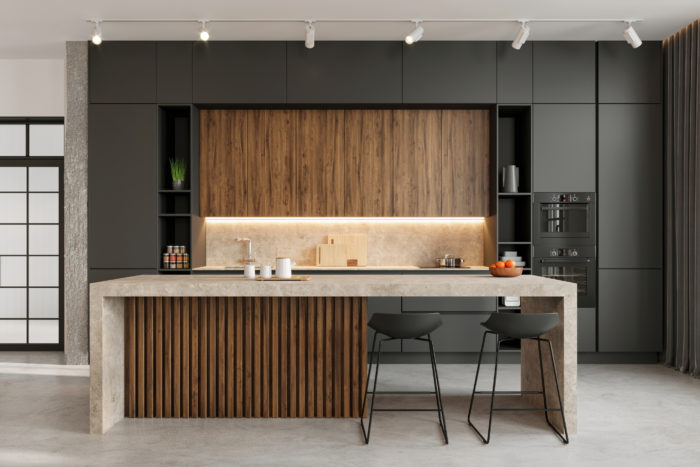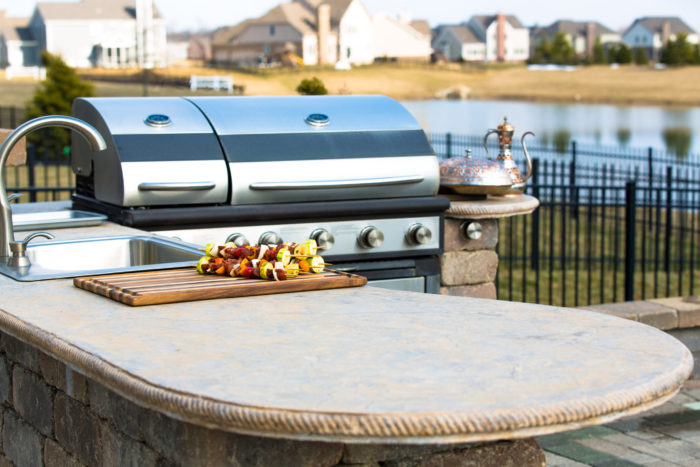The Beauty of Concrete Countertops
Does the idea of a concrete countertop seem a little boring or cold? Think again! Thanks to the incredible customization options of concrete, a concrete countertop can be a beautiful, warm feature that is both functional and design-forward. Learn about the pros and cons of concrete and decide if they’re right for your project!
Benefits of concrete countertops
Concrete countertops are a great option for commercial spaces, like bars and restaurants, but they also work well in homes. Whether kitchens, backyard patios, or even bathrooms, concrete counters are a beautiful addition.

Pro: Completely customizable
This is definitely the biggest perk to a concrete counter! Thanks to the available textures and finishes, your countertop can match literally any design style, whether you want a rustic look, a modern look, or something in-between. Thanks to stamps and an array of tinting options, your concrete can mimic tile, wood, marble, granite, and more! Plus, consider polishing the surface or embedding stone or decorative glass for a truly one-of-a-kind piece. Thanks to the handmade nature of a concrete countertop, it’s also easy to cast useful features like trivets or cutting boards.
Pro: Durable
Durability is another major benefit when it comes to concrete countertops. Not only is concrete inherently durable, but countertop concrete mixes usually contain glass fibers too, which enhances the overall strength. This mix means that both overhangs and seamless sections are no problem. When properly sealed and maintained, a concrete countertop can last 50 years!
Drawbacks to concrete countertops
Concrete has a few drawbacks, too, although we tend to think the pros outweigh any cons!
Con: Staining
Concrete countertops are susceptible to some staining. And since these countertops last so long, you’ll want to make sure you’re prepared to mitigate any stain damage. Regular applications of sealer and wax will help protect the surface. Any spills need to be taken care of immediately – don’t let liquid sit on the surface. But personally? We love not having to clean grout lines!
Possible cons: Time and cost
Comparing the time and money it takes to install a concrete countertop versus a more conventional material is tricky. In general, it used to be that concrete counters took longer to install due to their handcrafted and custom nature. (Plus, concrete needs to cure!) The cost also tended to be higher due to the labor. But in 2022, much of this conventional wisdom has been thrown out the window thanks to high demand, labor shortages, and material shortages. To best compare these factors, you’ll probably need to get some real-life quotes. The situation is so dynamic that it’s hard to estimate.
Is a concrete countertop right for your project?
Weighing the pros and cons is very much up to the specifics of the project. However, we tend to think that concrete’s 50-year lifespan and vast customization options outweigh any cons. (We love concrete, though, so we may be biased!) Our overall opinion tends to be that concrete is a good fit if you have a unique counter setup, you want all the bells and whistles, and you love to make a statement!
How is a concrete countertop installed?
It sounds like a major job if you don’t know how concrete is installed, but a professional will make it look easy. Countertops can either be poured in place or precast.
A precast involves building a mold, pouring the concrete, letting it cure, and then installing it in place. This method can work for certain projects and it provides many customization options, especially when it comes to embedding cool materials. However, it’s difficult to use edge molds and creating holes for sinks or faucets can get confusing. Not to mention that moving the finished piece into place is a significant undertaking.
Pouring in place is a popular option that many contractors find to be easier. It consists of covering the existing cabinets with plywood and building a form around the edges. Concrete is poured into the form and, once fully dry, the form is removed to reveal the new counter. This method works extremely well for including fancy edge molds and it also removes the necessity of moving a very large and heavy piece of concrete through your home.
How should you maintain your concrete countertop?
To keep your counter looking great for decades, it’s usually recommended to take a few steps.
- Apply a food-safe wax if your counter will be used as a food prep area.
- Reseal your counter once a year to prevent stains and water absorption.
- Wipe up spilled liquids immediately.
- Clean the counter with a mixture of dish soap and water.
- Don’t use any abrasive cleaners.
- Use trivets for hot pans since they can damage the sealer.

Contact Calico Construction Products
Ready to get started on a concrete countertop project? Contact Calico at 800-221-9469 if you want to chat. Our concrete pros are happy to talk through any problems or questions you have. Or if you’re ready to get shopping, shop our selection of concrete stamps, form and edge liners, colors, and sealers.
Categories: Concrete Stamps, Concrete Trends, Decorative Concrete
